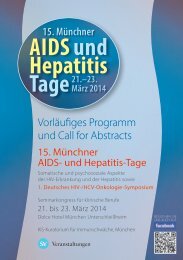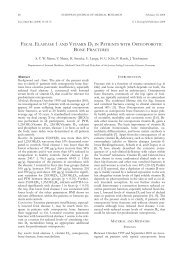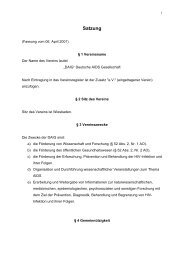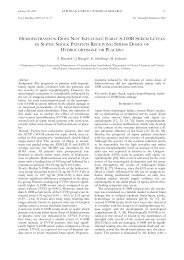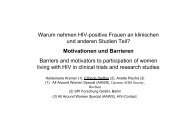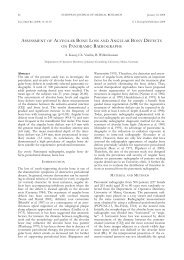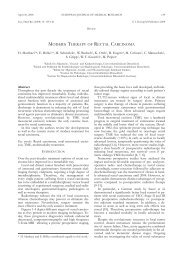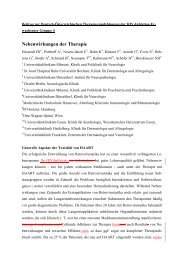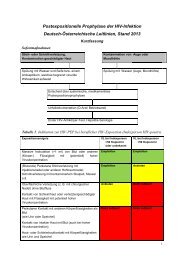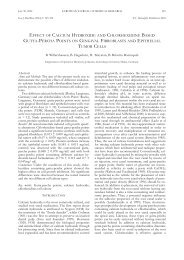European Journal of Medical Research - Deutsche AIDS ...
European Journal of Medical Research - Deutsche AIDS ...
European Journal of Medical Research - Deutsche AIDS ...
You also want an ePaper? Increase the reach of your titles
YUMPU automatically turns print PDFs into web optimized ePapers that Google loves.
June 27, 2007 EUROPEAN JOURNAL OF MEDICAL RESEARCH<br />
41<br />
pre- and post-intervention phases was obtained. Economic estimates<br />
were used to design the studies: The (moderate) costs<br />
<strong>of</strong> applying effectless interventions (type-I-error rate) and the<br />
(very high) theoretical costs <strong>of</strong> new HIV-infections without<br />
the intervention (type-II-error rate) were “translated” into designs<br />
with increased levels <strong>of</strong> significance (up to 30 %),<br />
which is unusual in conventional experimentation.<br />
Results: An effect <strong>of</strong> the intervention could be detected.<br />
Model estimations showed that between 2 and 8 HIV-infections<br />
were prevented by the intervention in the period<br />
from1998 to 2005, and thus had saved costs up to 5.9 million<br />
Euros, with project costs <strong>of</strong> 30.000,--.<br />
Conclusions: The current practice <strong>of</strong> an arbitrary specification<br />
<strong>of</strong> error rates may result in wrong decisions with the<br />
detrimental consequence <strong>of</strong> stopping effective interventions.<br />
Thus, an interdiscipinary strategy for specifying an appropriate<br />
level <strong>of</strong> significance was developed, by combining psychological<br />
methodology and health economics. The risk <strong>of</strong><br />
“reporting effects that don’t exist“ and the risk <strong>of</strong> “failing to<br />
see existing effects“ are balanced by using the monetary values<br />
<strong>of</strong> each error’s respective consequences. In general, even<br />
very small effects “pay for the investment” in HIV prevention,<br />
but such effects <strong>of</strong>ten can not be detected when conventional<br />
levels <strong>of</strong> significance are used.<br />
A.40 (Poster)<br />
„ … aber sicher. Informationen für Jugendliche zu<br />
Liebe, Sexualität und <strong>AIDS</strong>“ – Schüler schreiben<br />
und gestalten eine Informationsbroschüre für<br />
Schüler<br />
Krause K. 1<br />
1 <strong>AIDS</strong>-AUFKLÄRUNG e.V., Frankfurt, Germany<br />
Fragestellung: Werden Jugendliche gezielter angesprochen,<br />
wenn sie an der Erarbeitung von Informationsmaterialien<br />
beteiligt sind? Die heutige Informationsflut macht eine Selektion<br />
nach Gehalt und Bedeutung schwierig und das nicht nur<br />
für Jugendliche. Auf den ersten Blick müssen sich Jugendliche<br />
angesprochen fühlen und die Thematik erkennen<br />
können. In der entwickelten Schüler-Broschüre lassen sich<br />
schnell die wichtigsten Informationen zu HIV und <strong>AIDS</strong> finden.<br />
Sie bietet einen Überblick, ohne Panik zu machen. Trotz<br />
des ernsten Themas soll das Besondere der ersten Liebe erhalten<br />
bleiben. Die jugendgerechte Gestaltung regt zum Nachdenken<br />
und zur Auseinandersetzung mit dem Thema an. In<br />
den Medien sind Bilder die Schlüsselreize bei der Aufnahme<br />
von neuen Informationen. Ergo: will man Informationen/Fakten<br />
transportieren, braucht man (zielgruppengerechte) Bilder.<br />
Diese wurden für die Broschüre gemeinsam mit den Schülern<br />
entwickelt.<br />
Methoden: Projektarbeit als intensive Auseinandersetzung<br />
mit dem Thema an sich: Einstimmungsphase – Umsetzungsphase<br />
– Fertigstellungsphase. Schüler werden zu Multiplikatoren.<br />
Entwicklung einer jugendgerechten Informationsbroschüre:<br />
die Schüler arbeiteten als Texter, Organisatoren<br />
und Graphiker.<br />
Ergebnisse: Präsentation einer zielgruppengerechten Informationsbroschüre.<br />
Es werden die ersten Ergebnisse nach<br />
sechs Monaten Befragung/Rückmeldung von Schülern in verschiedenen<br />
Schulen dargestellt.<br />
Schlussfolgerungen: Diskussion darüber, wie man solch ein<br />
Broschüren-Projekt mit Schülern durchführen kann. Zielgruppengerechte<br />
Informationsmaterialien zu HIV/<strong>AIDS</strong> sind ein<br />
deutlicher Punkt im Bereich der Aufklärung. Dennoch: diese<br />
Art der Zusammenarbeit mit einer Zielgruppe ist<br />
zeitaufwendig und deshalb wahrscheinlich nicht überall umsetzbar.<br />
A.41 (Poster)<br />
Seroprevalence <strong>of</strong> HIV infection among patients<br />
attending the pre-pregnancy class at prenatal<br />
diagnosis and therapy centre, college <strong>of</strong> medicine,<br />
University <strong>of</strong> Lagos. A nine years review<br />
Ajayi G. 1 , Omilabu S. 1 , Alamu D. 1 , Balogun Y. 1 , Badaru S. 1<br />
1 Prenatal Diagnosis and Therapy Center, Tertiary Hospital,<br />
Lagos, Nigeria<br />
Objective: To study the sero prevalence <strong>of</strong> HIV infection in<br />
the pre-pregnancy period in a tertiary care centre in Lagos.<br />
Setting: Prenatal Diagnosis and Therapy Centre <strong>of</strong> a Tertiary<br />
Hospital in Lagos.<br />
Design: A cross sectional study.<br />
Materials and methods: Blood samples <strong>of</strong> males and females<br />
referred to pre-pregnancy class with written consent<br />
were collected and tested for HIV antibodies between 1997<br />
and 2005. Only those who are HIV sero positive were included<br />
in this study. Partners <strong>of</strong> sero positive were also counseled<br />
and tested. Statistical analysis was done using Chi-square test.<br />
Result: Out <strong>of</strong> a total <strong>of</strong> n=1886 screened, n=73 (3.87%) were<br />
found to be sero reactive or sero positive. The highest sero<br />
prevalence <strong>of</strong> HIV was in the year 2004 with (n=17) 9.39%.<br />
The majority <strong>of</strong> sero active n=39 were in the age group 26-35<br />
years. The total male: female ratio was 1:2.7(20:53).<br />
Conclusion: In the present study, sero prevalence <strong>of</strong> HIV infections<br />
was found to be high (3.87%) among pre-pregnancy<br />
class in Lagos. There is need to reduce this high prevalence<br />
by targeting an intervention program towards high risk and<br />
vulnerable groups in the society. Apart from these patients attending<br />
such pre-pregnancy class, patients should consider<br />
this and be screened before and after any procedure.<br />
A.42 (Poster)<br />
Effect <strong>of</strong> Zinc therapy in HIV positive pregnancies<br />
Ajayi G. 1 , Omilabu S. 1 , Alamu D. 1 , Balogun Y. 1 ,<br />
Badaru S. 1<br />
1 Prenatal Diagnosis and Therapy Center, Tertiary Hospital,<br />
Lagos, Nigeria<br />
Objective: To measure the concentration <strong>of</strong> Zinc in HIV positive<br />
pregnant women and the effect <strong>of</strong> Zinc replacement therapy.<br />
Design: Longitudinal Study<br />
Setting: Prenatal Diagnosis and Therapy Centre in Tertiary<br />
Hospital in Lagos.<br />
Materials and methods: In HIV positive patients, Zinc concentrations<br />
were determined by Atomic Absorption Spectrophotometry<br />
(AAS) and patients were treated with 20-<br />
30mgZn/day orally for an average <strong>of</strong> 10 weeks apart from the<br />
Antiretroviral drug they were on.<br />
Result: Zinc concentration improved and was accompanied<br />
by a statistically significant increase from 0.846 to<br />
1.031mg/ml or 84.6 to 1031mg/l (9ppm)<br />
Conclusion: Our result shows that trace element deficiency <strong>of</strong><br />
Zinc is present in HIV positive patients and correlates with<br />
the CD4 count. The effect <strong>of</strong> adjuvant Zinc replacement therapy<br />
should be recommended.



